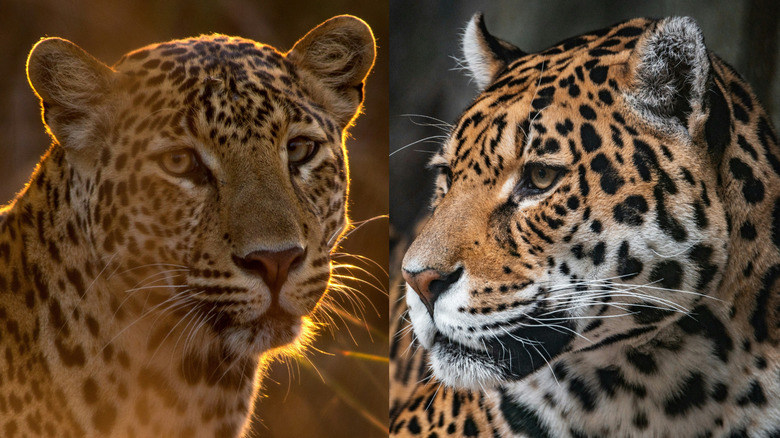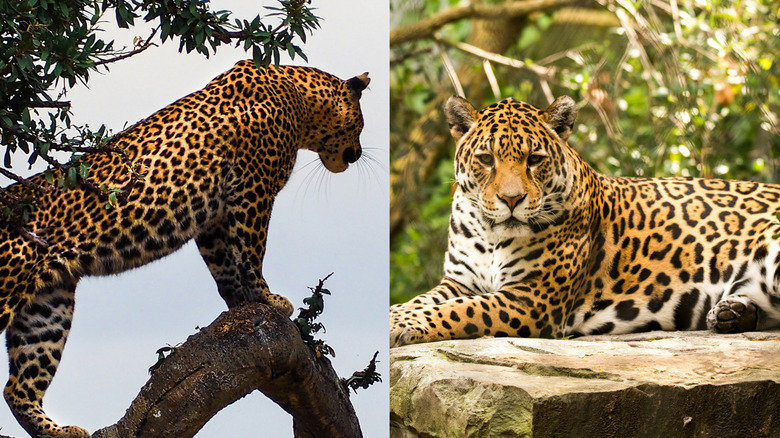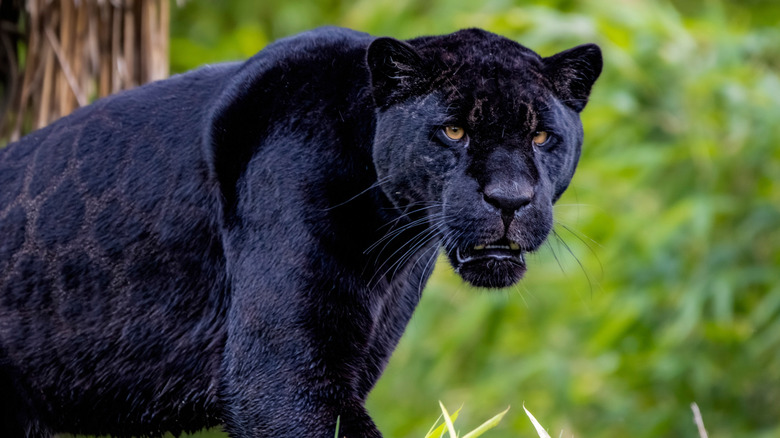No, A Leopard And A Jaguar Aren't The Same Animal. Here's The Difference
Leopards and jaguars are two of the most visually striking big cats on Earth. In fact, they're so striking in such similar ways that they're often confused for each other. Both have golden coats covered in black rosettes, both are solitary hunters, and both can take down prey far larger than themselves. But despite their surface similarities, these apex predators are entirely different species with distinct traits, ranges, and behaviors.
Part of the confusion stems from pop culture and media. Nature documentaries, news reports, and films featuring wildlife excursions often present these cats interchangeably, and the confusion is compounded when dealing with black panthers (more on them later). Even zookeepers and big cat experts take their time when distinguishing between these two species when viewing photos or observing them in their natural habitats. Add the fact that both animals are elusive and prefer to spend time in the cover of dense habitats, and it's no wonder most people lump them together.
But once you start digging into the details, the differences reveal themselves surprisingly quickly. Leopards and jaguars live on different continents, have evolved unique hunting techniques, and carry defining physical traits that can help even the casual observer tell them apart. It just so happens that their shared look is a likely case of convergent evolution — a phenomenon in which unrelated species evolve similar traits or behaviors — not closeness in the family tree. So, if you've ever wanted to know which spots belong to which cat, we've got you covered.
How to tell leopards and jaguars apart
The easiest way to tell if you're looking at a leopard or a jaguar is based on where you're viewing them. Every jaguar in the wild is part of a single species whose range extends from Mexico to Argentina. Leopards, on the other hand, occupy the Old World, covering the western, middle, and southern parts of Africa, the Middle East, and Asia. But if you're viewing these animals in a zoo or wildlife exhibit instead, the surefire visual giveaway can be found in the animal's spots. Jaguars and leopards both exhibit rosettes (small, rose-shaped splotches) on their fur. Leopards tend to have more solidly "filled-in" spots on their bodies, while jaguar rosettes often feature smaller dots and other patterns within theirs. The key is to get a good, broadside look at their torsos, where the difference presents itself most clearly.
If the spots don't give it away, the animals' size and shape will. Jaguars are stockier overall, with broader heads, wider paws, and shorter tails than leopards. They're also far heavier, weighing up to 350 pounds, while leopards max out at around 200 pounds. The animals are also behaviorally distinct. Jaguars are expert swimmers, and those that inhabit the Brazilian Pantanal wetlands use the water to their advantage when hunting. Leopards avoid water when they can, and after a kill, drag their prey into the tops of trees to prevent it from being stolen by other predators.
Compared to the snow leopard, which isn't as dangerous to humans as you'd expect, both jaguars and leopards are deadly predators. Leopards have been known to kill and drag prey weighing up to 140% of their body mass up trees, and jaguars are strong enough to carry massive caimans in their jaws as they swim.
Jaguar evolution, and the myth of the black panther
Leopards and jaguars exhibit fascinating adaptations unique to each species. Jaguars boast the strongest bite of any big cat relative to size, one powerful enough to pierce the skull of any animal. Leopards, meanwhile, are renowned climbers and among the most adaptable big cats on Earth, capable of surviving everywhere from African savannas to the snow-dusted reaches of the Himalayas. Taxonomically, both animals belong to the Panthera genus, which includes the world's four true big cats: leopards, jaguars, lions, and tigers. But jaguars are a particularly intriguing case study in big cat evolution.
Jaguars diverged from a common ancestor shared with leopards and lions around 3 million years ago, later migrating east across Eurasia and into the Americas via the Bering Land Bridge. As a result, they exist as a single species across Central and South America. Despite their previous multi-continent range, jaguars are now listed as "near-endangered" due to habitat loss and poaching, similar reasons that caused the tragic extinction of the Barbary lion. Then there's the issue of the "black panther." As common as the term is when talking about big cats, it's not a scientific classification at all. Rather, it's simply a term used to describe jaguars and leopards (and sometimes other big cats) that exhibit black fur due to an overproduction of melanin.
So, the next time you get these cats or their names jumbled, don't feel too bad — the world of big cats is a wild one. Leopard-jaguar mixups are just as common as the misconception that buffalo and bison are the same thing. But now, you've got the tools you need to impress your friends the next time you watch a BBC nature documentary.


